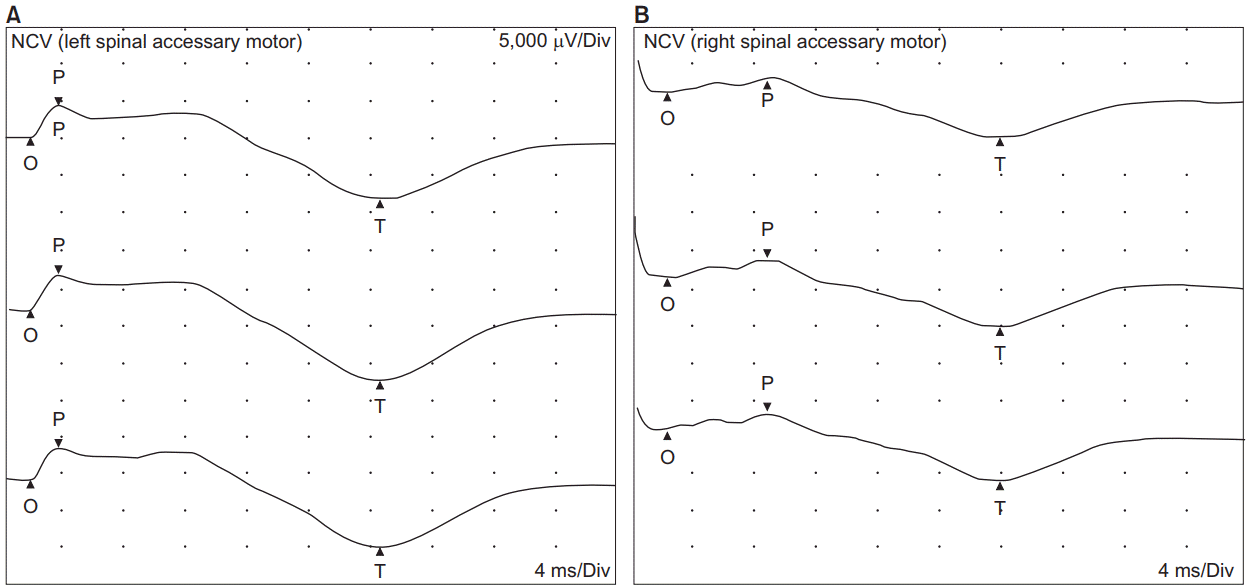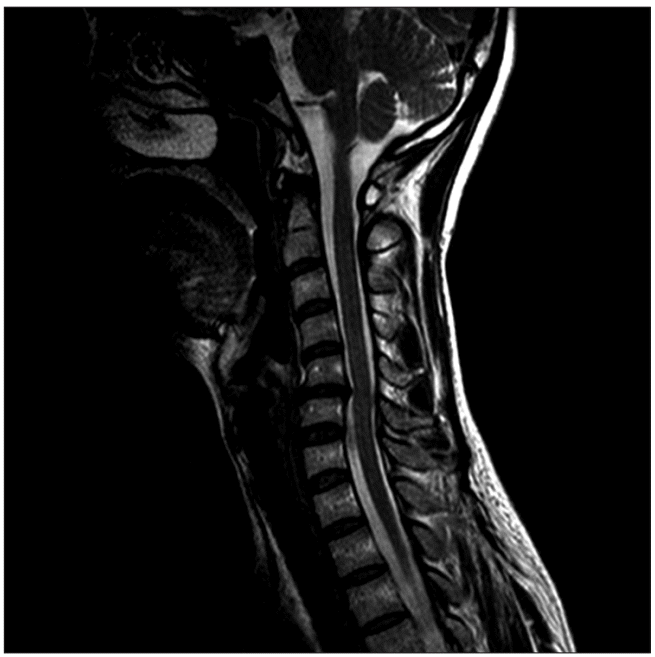Abstract
Spinal accessory nerve (SAN) injury mostly occurs during surgical procedures. SAN injury caused by manipulation therapy has been rarely reported. We present a rare case of SAN injury associated with manipulation therapy showing scapular winging and droopy shoulder. A 42-year-old woman visited our outpatient clinic complaining of pain and limited active range of motion (ROM) in right shoulder and scapular winging after manipulation therapy. Needle electromyography and nerve conduction study suggested SAN injury. Physical therapy (PT) three times a week for 2 weeks were prescribed. After a total of 6 sessions of PT and modality, the patient reported that the pain was gradually relieved during shoulder flexion and abduction with improved active ROM of shoulder. Over the course of 2 months follow-up, the patient reported almost recovered shoulder ROM and strength as before. She did not complain of shoulder pain any more.
Spinal accessory nerve (SAN) injury mostly occurs during surgical procedures such as cervical lymph node biopsy, neck dissection for tumor resection, and carotid endarterectomy. However, other causes such as stretch or traction injury, blunt trauma, penetrating injury, and Parsonage-Turner syndrome represented by inflammatory process have also been reported [1-3].
SAN solely innervates the upper third of the trapezius muscle whereas cervical spinal motor roots innervate the lower two-thirds. SAN travels obliquely over the posterior triangle on the levator scapula muscle and then innervates the trapezius muscle. SAN is very susceptible to injury at the posterior cervical triangle because it courses superficially. It is coated only with skin and subcutaneous fascia. In the posterior triangle, SAN is stretched when the shoulder droops and the head is rotated to the opposite direction [3-5].
SAN injury causes weakness of the trapezius muscle. It also causes weakness of sternocleidomastoid muscle, although less frequently. The primary role of trapezius is to stabilize the scapula when the glenohumeral joint is moved. A stable scapula allows the glenohumeral joint to move in a coordinated manner so that the center of glenohumeral joint motion is maintained during full range of motion (ROM) [6]. The weakness of the trapezius muscle consequently causes scapular dyskinesis that is instability of scapular motion and positioning. Trapezius weakness causes depression of shoulder girdle, scapular drooping, and winging of the scapula characterized by lateral displacement. Patients with serious upper trapezius weakness cannot abduct their shoulders more than 90°. They complain of pain, weakness, and stiffness in the upper limbs especially shoulders, particularly when patients raise their arms over the head [6-8].
Manipulation therapy is frequently applied as a modality to treat neck pain. We present a rare case of SAN injury associated with manipulation therapy, causing scapular winging and droopy shoulder due to trapezius muscle weakness. Our case demonstrates that neck stretching manipulation therapy can cause adjacent nerve injury.
A 42-year-old woman visited our outpatient clinic, complaining of pain and limited active ROM in right shoulder after cervical spinal manipulation therapy at a local clinic. She had received manipulation therapy to manage posterior neck pain and radiating pain with right upper limb at a local clinic for 5 months. Five days before the visit, she received manipulation therapy with thrusting and stretching neck and shoulders. She reported no history of shoulder or neck trauma.
Physical examination revealed limited active ROM of right shoulder joint during abduction and flexion. Lateral edge of the right scapula appeared to be more prominent and winged during shoulder abduction. Shoulder elevation was impaired with droopy shoulder, although trapezius muscle did not seem to be wasted. There was mildly diffuse tenderness along the right trapezius muscle during palpation. Passive right shoulder ROM was preserved. There was no loss of sensation. Neurologic examinations revealed nothing abnormal.
Magnetic resonance imaging (MRI) revealed cervical herniated nucleus pulposus in C4-5 and C5-6 (Fig. 1). Ultrasonography of neck and shoulder was unremarkable. Needle electromyography (EMG) and nerve conduction study (NCS) were performed. Motor NCS of spinal accessory nerves recorded from the right upper trapezius muscle showed that the amplitude of compound muscle action potential was reduced over 50% with delayed onset latency over 30% compared to the left side (Fig. 2). Needle EMG studies revealed positive sharp waves, reduced recruitment pattern, and discrete interferential pattern of motor unit potentials in the right upper trapezius muscle (Tables 1, 2).
Physical therapy (PT) sessions three times a week for 2 weeks were prescribed. Assisted gentle ROM and strengthening exercises were performed. Pain relieving modalities including superficial heat and ultrasound were applied to reduce the pain resulting from decompensation for weakness. Electrical stimulation therapy on the right upper trapezius muscle was also performed to avoid additional wasting of trapezius muscle. After a total of 6 sessions of PT and modality, the patient reported that the pain was gradually relieved during shoulder flexion and abduction with improved active ROM of shoulder. Over the course of 2 months follow-up, the patient reported almost recovered shoulder ROM and strength as before. She did not complain of shoulder pain any more.
Only six cases of nerve injuries of upper limb following massage therapy such as Shiatsu massage or deep tissue massage have been reported, including injuries to the recurrent motor branch of median nerve, posterior interosseous nerve, radial nerve on spiral groove, brachial plexus, and SAN [9]. Phrenic nerve injury and long thoracic nerve injury following cervical spinal manipulation have also been reported, although vessel injuries such as carotid artery dissection and vertebral artery dissection are reported mostly [10]. Aksoy et al. [1] reported that a 38-year-old woman had SAN injury following a single session of deep tissue massage. She presented winged scapular and droopy shoulder caused by trapezius muscle weakness. After diagnosed with SAN injury by EMG, she was prescribed PT for 6 weeks and discharged with a home exercise program. During 2 years of follow-up, she recovered strength incompletely.
SAN injury related to manipulation therapy is a rare mechanism of nerve injury. A cadaveric study showed the SAN was anchored by branches so that the nerve was strained between the anterior margin of the trapezius and the posterior margin of the sternocleidomastoid muscle [5]. Thus, when the shoulder is pulled down and the head is turned to the opposite direction, the SAN is stretched in the posterior triangle [5]. Our patient was also treated with manipulation therapy for thrusting and stretching neck and shoulders, similar to the method mentioned above.
In this case, clinical diagnosis was clearly demonstrated by EMG. Although diffuse edema of the muscle on MRI was a suspicious finding of denervation, EMG was the most diagnostic tool for confirming denervation. Spinal manipulation is frequently used to treat mostly musculoskeletal problems by healthcare professionals such as doctors, chiropractors, physiotherapists, and osteopaths. This review suggests that cervical spinal manipulation therapy has potential risk of causing nerve injury, including SAN injury. High velocity thrusts with rotational movement of the cervical spine seem to result in complications [10]. Thus, therapist who performs cervical manipulation therapy in this region should be cautious. When unusual symptoms such as motor weakness or disproportionate sensory change occurs, manipulation therapy should be stopped to prevent further injury. Close observation is required when symptom develops.
REFERENCES
1. Aksoy IA, Schrader SL, Ali MS, Borovansky JA, Ross MA. Spinal accessory neuropathy associated with deep tissue massage: a case report. Arch Phys Med Rehabil. 2009; 90:1969–72.

2. Bodack MP, Tunkel RS, Marini SG, Nagler W. Spinal accessory nerve palsy as a cause of pain after whiplash injury: case report. J Pain Symptom Manag. 1998; 15:321–8.
4. Porter P, Fernandez GN. Stretch-induced spinal accessory nerve palsy: a case report. J Shoulder Elbow Surg. 2001; 10:92–4.

5. Lu L, Haman SP, Ebraheim NA. Vulnerability of the spinal accessory nerve in the posterior triangle of the neck: a cadaveric study. Orthopedics. 2002; 25:71–4.

6. Coulter JM, Warme WJ. Complete spinal accessory nerve palsy from carrying climbing gear. Wilderness Environ Med. 2015; 26:384–6.

7. Kelley MJ, Kane TE, Leggin BG. Spinal accessory nerve palsy: associated signs and symptoms. J Orthop Sports Phys Ther. 2008; 38:78–86.

8. Kibler WB, McMullen J. Scapular dyskinesis and its relation to shoulder pain. J Am Acad Orthop Surg. 2003; 11:142–51.

Fig. 2.
(A) Normal ranges of onset latency and amplitude of compound muscle action potential (CMAP) in the left upper trapezius muscle. (B) Delayed onset latency and decreased amplitude of CMAP in the right upper trapezius muscle.





 PDF
PDF Citation
Citation Print
Print




 XML Download
XML Download